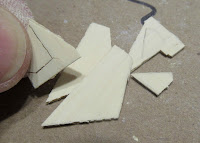You should do some dry positioning to get a better orientation of the black "swirl" decal and a centering for the TAZZ name decal.
The top edge of the swirl decal sits at tube/nose cone joint but doesn't go entirely around the body tube.
In the lower picture I taped the swirl decal in place to get the Z in line with the swirl point.
Here's both decals in correct position.
The wing decals are a little confusing. Don't soak them until you are sure of the positioning.
The rear black edges were cut very close to the ink border.
























































